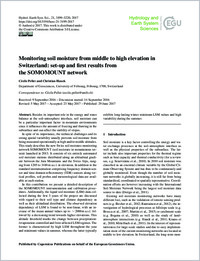Monitoring soil moisture from middle to high elevation in Switzerland: set-up and first results from the SOMOMOUNT network
- Pellet, Cécile Department of Geosciences, University of Fribourg, Switzerland
- Hauck, Christian Department of Geosciences, University of Fribourg, Switzerland
-
29.06.2017
Published in:
- Hydrol. Earth Syst. Sci.. - 2017, vol. 21, no. 6, p. 3199–3220
English
Besides its important role in the energy and water balance at the soil–atmosphere interface, soil moisture can be a particular important factor in mountain environments since it influences the amount of freezing and thawing in the subsurface and can affect the stability of slopes. In spite of its importance, the technical challenges and its strong spatial variability usually prevents soil moisture from being measured operationally at high and/or middle altitudes. This study describes the new Swiss soil moisture monitoring network SOMOMOUNT (soil moisture in mountainous terrain) launched in 2013. It consists of six entirely automated soil moisture stations distributed along an altitudinal gradient between the Jura Mountains and the Swiss Alps, ranging from 1205 to 3410 m a.s.l. in elevation. In addition to the standard instrumentation comprising frequency domain sensor and time domain reflectometry (TDR) sensors along vertical profiles, soil probes and meteorological data are available at each station. In this contribution we present a detailed description of the SOMOMOUNT instrumentation and calibration procedures. Additionally, the liquid soil moisture (LSM) data collected during the first 3 years of the project are discussed with regard to their soil type and climate dependency as well as their altitudinal distribution. The observed elevation dependency of LSM is found to be non-linear, with an increase of the mean annual values up to ∼ 2000 m a.s.l. followed by a decreasing trend towards higher elevations. This altitude threshold marks the change between precipitation-/evaporation-controlled and frost-affected LSM regimes. The former is characterized by high LSM throughout the year and minimum values in summer, whereas the latter typically exhibits long-lasting winter minimum LSM values and high variability during the summer.
- Faculty
- Faculté des sciences et de médecine
- Department
- Département de Géosciences
- Language
-
- English
- Classification
- Hydrology
- License
-
License undefined
- Identifiers
-
- RERO DOC 305069
- DOI 10.5194/hess-21-3199-2017
- Persistent URL
- https://folia.unifr.ch/unifr/documents/305886
Statistics
Document views: 118
File downloads:
- pdf: 188
